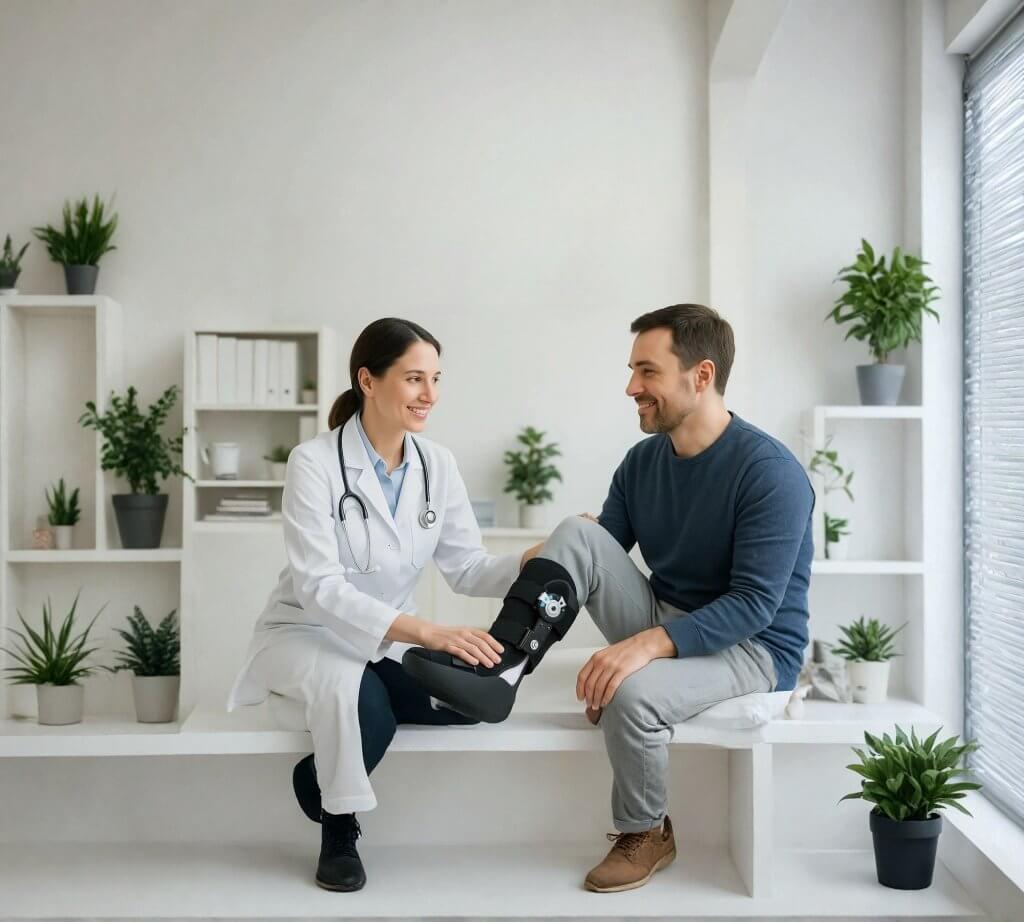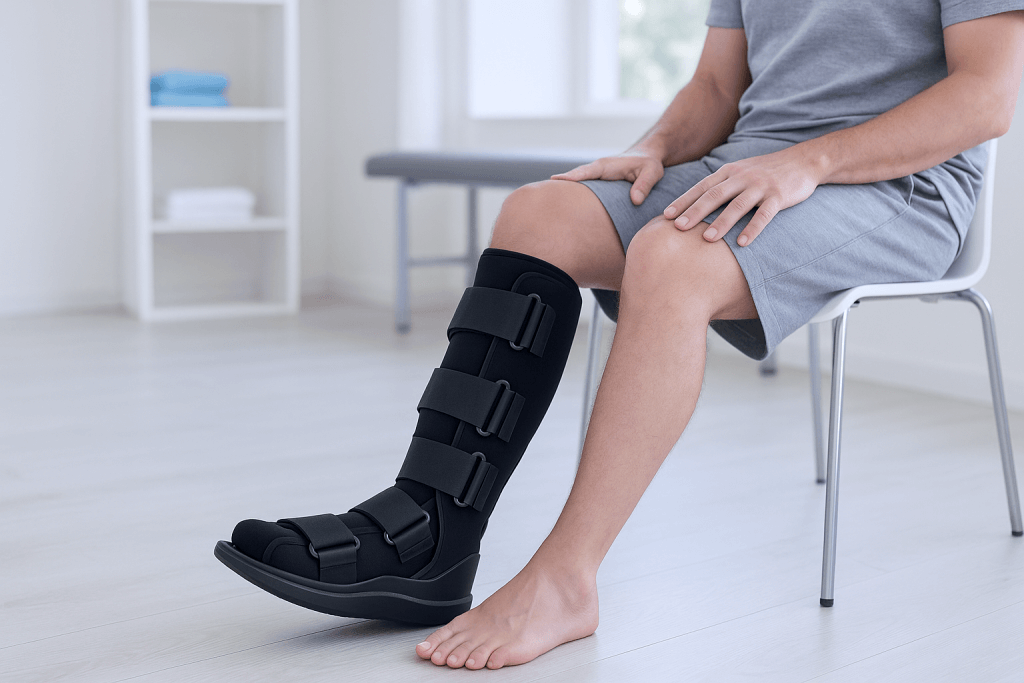During ankle injuries or post-surgical recovery, selecting the right walking boot (also known as a CAM walker or orthopedic boot) is crucial for rehabilitation quality. As professional medical rehabilitation equipment, walking boots provide necessary protection and support through scientific design, making the recovery process safer and more comfortable. This guide will detail the functional features, selection criteria, proper usage methods, and rehabilitation recommendations for walking boots to help you fully understand this important rehabilitation aid.
Core Functions and Value of Walking Boots
Walking boots (also called orthopedic walking boots) are specialized medical devices designed for foot and ankle injuries, with key functions including:
- Stabilization and Protection: Through rigid shells and internal padding systems, they provide comprehensive protection to injured areas, preventing secondary damage from improper movement.
- Pressure Distribution: Specially designed soles evenly distribute body weight, significantly reducing pressure on injured areas.
- Angle Adjustment: Most products offer adjustable fixation angles that can be gradually modified according to recovery stages.
- Comfortable Support: High-quality lining materials provide cushioning while maintaining breathability for extended wear.
- Progressive Rehabilitation: As conditions improve, usage can be gradually adjusted for smooth transition from complete immobilization to partial weight-bearing.
Five Key Factors for Scientifically Selecting Walking Boots
1. Identify Injury Type and Recovery Needs
Different foot/ankle issues require different boot features:
- Achilles injuries: Need heel support and plantar flexion restriction
- Ankle fractures: Require complete immobilization and rigid support
- Post-surgical recovery: May need professional adjustable-angle models
- Chronic conditions: Should prioritize long-term wear comfort
2. Evaluating Key Product Parameters
- Size Fit: Quality products offer multiple sizes for perfect leg contour matching
- Material Composition: Medical-grade foam lining and lightweight shells are basic requirements
- Adjustment System: Convenient straps and air pressure adjustment enhance user experience
- Weight Control: Ideal weight between 0.7-1.2kg; excessive weight increases walking burden
- Certification Standards: Medical device certifications ensure safety and effectiveness
3. Usage Scenario Considerations
- Daily Activity Level: Active users need more durable structural designs
- Climate Environment: Breathability is especially important in hot/humid regions
- Clothing Needs: Certain designs facilitate easier wearing/removal with daily attire
4. Professional Medical Advice
Consult doctors or physical therapists before purchasing to understand:
- Required fixation angles
- Expected duration of use
- Weight-bearing transition plan
- Special precautions
5. Balancing Cost and Performance
Find the right balance between professional-grade and economical options based on recovery duration and injury severity to maximize return on investment.
Complete Guide to Using Walking Boots
Proper Wearing Procedure
- Completely loosen all straps and adjustment devices
- Gently slide foot into boot, ensuring heel is fully positioned
- Tighten straps sequentially from distal to proximal, maintaining even pressure distribution
- Adjust air cushions to comfortable support level
- Initial use should be guided by professionals
Daily Maintenance Essentials
- Regularly clean linings to maintain hygiene
- Check straps and adjustment devices for proper function
- Avoid contact with sharp objects to prevent shell damage
- Dry promptly when damp to prevent bacterial growth
Rehabilitation Exercise Integration
Under professional medical guidance, gradually progress through:
- Initial phase: Non-weight-bearing exercises
- Mid-phase: Light weight-bearing training
- Later phase: Balance and proprioception recovery
- Final phase: Smooth transition to regular footwear
Frequently Asked Questions
Q: How long should walking boots typically be worn?
A: Generally 4-8 weeks, depending on injury severity and recovery progress—always follow medical advice.
Q: Should they be worn during nighttime rest?
A: Unless specifically recommended by doctors, they can usually be removed at night to allow skin and soft tissue rest.
Q: Are walking boots waterproof? Can they be worn while showering?
A: Unless specifically designed as waterproof models, most products aren’t waterproof and shouldn’t be worn while showering.
Q: How to determine proper fit?
A: Heel should be securely positioned with slight toe movement space; straps shouldn’t cause discomfort or pressure when fastened.
Q: What’s the difference between walking boots and regular ankle braces?
A: Walking boots provide more comprehensive immobilization and support for serious injuries/post-surgical recovery, while ankle braces suit mild sprains or preventive protection.
Professional Purchasing Advice
For Individual Users:
- Always obtain professional medical advice first
- Accurately measure calf circumference and foot size
- Choose authorized channels with return policies
- Consider rental options for short-term needs
For Medical Institutions:
- Focus on clinical validation data
- Consider diverse patient population needs
- Evaluate long-term durability
- Prioritize after-sales service and accessory supply
Your Professional Companion for Recovery
Choosing the right walking boot is a critical decision in the rehabilitation process. Quality products not only promote healing but significantly improve quality of life during recovery. Whether for sports injuries, accidents, or post-surgical recovery, scientifically selecting and using walking boots will provide solid support for your rehabilitation journey.
Remember, the best walking boots should perfectly balance medical effectiveness, wearing comfort, and lifestyle convenience. Making informed choices under professional guidance lays a solid foundation for successful recovery.
We hope this guide’s professional advice helps you better understand and select walking boot products. For more personalized recommendations, please consult your medical team. Wishing you a speedy recovery and renewed vitality!

